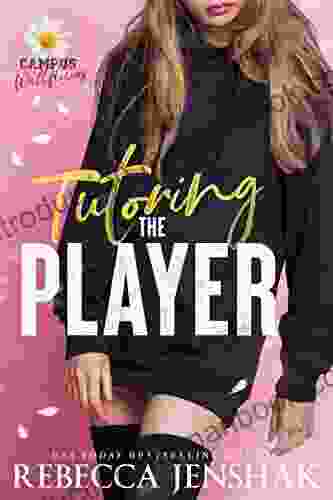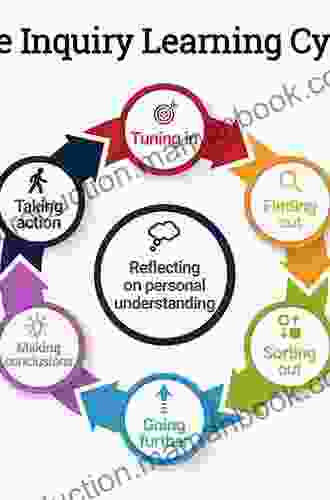25 Engaging Strategies for Inquiry-Based Learning

Inquiry-based learning is a powerful approach to teaching and learning that encourages students to develop critical thinking, problem-solving, and communication skills. By engaging students in the process of discovery, inquiry-based learning helps them to become more independent learners and to develop a deeper understanding of the world around them.
4.5 out of 5
| Language | : | English |
| File size | : | 17777 KB |
| Screen Reader | : | Supported |
| Print length | : | 208 pages |
There are many different ways to implement inquiry-based learning in the classroom. In this article, we will explore 25 engaging strategies that you can use to get started.
1. Ask Open-Ended Questions
One of the most important aspects of inquiry-based learning is asking open-ended questions. These types of questions encourage students to think critically and to explore multiple perspectives. When asking open-ended questions, avoid questions that can be answered with a simple yes or no. Instead, ask questions that require students to explain their thinking and to provide evidence to support their claims.
2. Encourage Student Curiosity
Students are naturally curious, so it is important to encourage their curiosity and to provide them with opportunities to explore their interests. Allow students to ask questions, follow their own lines of inquiry, and to make connections between their learning and the world around them.
3. Provide Hands-On Activities
Hands-on activities are a great way to engage students in learning and to help them to develop a deeper understanding of concepts. When planning hands-on activities, be sure to provide students with clear instructions and to allow them enough time to explore and to make discoveries.
4. Use Real-World Examples
Real-world examples can help students to connect their learning to the world around them and to see how the concepts they are learning are applied in the real world. When using real-world examples, be sure to provide students with context and to help them to make connections between the examples and the concepts they are learning.
5. Encourage Student Collaboration
Collaboration is a key component of inquiry-based learning. When students work together, they can share ideas, learn from each other, and develop a deeper understanding of the concepts they are learning. Encourage students to work together on projects, to discuss their ideas with each other, and to provide feedback to each other.
6. Use Technology
Technology can be a powerful tool for inquiry-based learning. There are many different ways to use technology to support inquiry-based learning, such as using online resources, creating multimedia presentations, and using online simulations.
7. Provide Feedback
Feedback is essential for inquiry-based learning. Feedback helps students to assess their progress, to identify areas where they need to improve, and to develop a deeper understanding of the concepts they are learning. Provide students with feedback on their work on a regular basis, and be sure to provide specific and constructive feedback.
8. Reflect on the Learning Process
Reflection is an important part of inquiry-based learning. Reflection helps students to make connections between their learning and their own experiences, to identify areas where they need to improve, and to develop a deeper understanding of the concepts they are learning. Encourage students to reflect on their learning on a regular basis, and provide them with opportunities to share their reflections with others.
9. Provide Opportunities for Student Choice
Student choice is an important part of inquiry-based learning. When students have a choice in their learning, they are more likely to be engaged and to develop a deeper understanding of the concepts they are learning. Provide students with opportunities to choose their own topics of study, to design their own projects, and to assess their own work.
10. Create a Learning Environment That Supports Inquiry
The learning environment plays a key role in inquiry-based learning. Create a learning environment that is open, flexible, and supportive of inquiry. Provide students with access to resources, and provide them with the time and space they need to explore and to make discoveries.
11. Use Problem-Based Learning
Problem-based learning is a type of inquiry-based learning that engages students in solving real-world problems. Problem-based learning can be used to teach a variety of subjects, and it can help students to develop critical thinking, problem-solving, and communication skills.
12. Use Case Studies
Case studies are a great way to engage students in inquiry-based learning and to help them to develop a deeper understanding of complex issues. Case studies can be used to teach a variety of subjects, and they can help students to develop critical thinking, problem-solving, and communication skills.
13. Use Simulations
Simulations are a great way to engage students in inquiry-based learning and to help them to develop a deeper understanding of complex systems. Simulations can be used to teach a variety of subjects, and they can help students to develop critical thinking, problem-solving, and communication skills.
14. Use Field Trips
Field trips are a great way to engage students in inquiry-based learning and to help them to connect their learning to the world around them. Field trips can be used to teach a variety of subjects, and they can help students to develop critical thinking, problem-solving, and communication skills.
15. Use Guest Speakers
Guest speakers are a great way to engage students in inquiry-based learning and to help them to learn from experts in the field. Guest speakers can be used to teach a variety of subjects, and they can help students to develop critical thinking, problem-solving, and communication skills.
16. Use Online Resources
Online resources are a great way to engage students in inquiry-based learning and to help them to access a wide range of information. Online resources can be used to teach a variety of subjects, and they can help students to develop critical thinking, problem-solving, and communication skills.
17. Use Project-Based Learning
Project-based learning is a type of inquiry-based learning that engages students in creating a project that demonstrates their understanding of a topic. Project-based learning can be used to teach a variety of subjects, and it can help students to develop critical thinking, problem-solving, and communication skills.
18. Use Inquiry Circles
Inquiry circles are a type of inquiry-based learning that engages students in discussing
4.5 out of 5
| Language | : | English |
| File size | : | 17777 KB |
| Screen Reader | : | Supported |
| Print length | : | 208 pages |
Do you want to contribute by writing guest posts on this blog?
Please contact us and send us a resume of previous articles that you have written.
 Top Book
Top Book Novel
Novel Fiction
Fiction Nonfiction
Nonfiction Literature
Literature Paperback
Paperback Hardcover
Hardcover E-book
E-book Audiobook
Audiobook Bestseller
Bestseller Classic
Classic Mystery
Mystery Thriller
Thriller Romance
Romance Fantasy
Fantasy Science Fiction
Science Fiction Biography
Biography Memoir
Memoir Autobiography
Autobiography Poetry
Poetry Drama
Drama Historical Fiction
Historical Fiction Self-help
Self-help Young Adult
Young Adult Childrens Books
Childrens Books Graphic Novel
Graphic Novel Anthology
Anthology Series
Series Encyclopedia
Encyclopedia Reference
Reference Guidebook
Guidebook Textbook
Textbook Workbook
Workbook Journal
Journal Diary
Diary Manuscript
Manuscript Folio
Folio Pulp Fiction
Pulp Fiction Short Stories
Short Stories Fairy Tales
Fairy Tales Fables
Fables Mythology
Mythology Philosophy
Philosophy Religion
Religion Spirituality
Spirituality Essays
Essays Critique
Critique Commentary
Commentary Glossary
Glossary Bibliography
Bibliography Index
Index Table of Contents
Table of Contents Preface
Preface Introduction
Introduction Foreword
Foreword Afterword
Afterword Appendices
Appendices Annotations
Annotations Footnotes
Footnotes Epilogue
Epilogue Prologue
Prologue Randi Alexander
Randi Alexander A K Scott
A K Scott Abraham Cruz
Abraham Cruz Feng Jie
Feng Jie Shaina Rudolph
Shaina Rudolph B H Fairchild
B H Fairchild Leigh Russell
Leigh Russell Dan Olmsted
Dan Olmsted Rachel Caine
Rachel Caine Khaled Belkeram
Khaled Belkeram Malcolm Surridge
Malcolm Surridge Persephone Autumn
Persephone Autumn A L Jambor
A L Jambor David F Walker
David F Walker Garrett Hongo
Garrett Hongo Vickie J S Hieb
Vickie J S Hieb Rebecca Cantrell
Rebecca Cantrell Lynn Thorndike
Lynn Thorndike Rochelle Summers
Rochelle Summers Eric Branscome
Eric Branscome
Light bulbAdvertise smarter! Our strategic ad space ensures maximum exposure. Reserve your spot today!

 Miguel de CervantesUnleash Your Inner Crochet Maven: Embark on a Creative Journey with Our Puff...
Miguel de CervantesUnleash Your Inner Crochet Maven: Embark on a Creative Journey with Our Puff...
 Gabriel Garcia MarquezUnveiling the Enigmatic Eye of the Beholder: Exploring the Profundity of...
Gabriel Garcia MarquezUnveiling the Enigmatic Eye of the Beholder: Exploring the Profundity of... Gregory WoodsFollow ·15.4k
Gregory WoodsFollow ·15.4k Herman MitchellFollow ·12.9k
Herman MitchellFollow ·12.9k Jeff FosterFollow ·5.3k
Jeff FosterFollow ·5.3k Chuck MitchellFollow ·7.7k
Chuck MitchellFollow ·7.7k David BaldacciFollow ·7.8k
David BaldacciFollow ·7.8k Jamie BellFollow ·12.2k
Jamie BellFollow ·12.2k Ernest ClineFollow ·5.3k
Ernest ClineFollow ·5.3k Eric HayesFollow ·10.8k
Eric HayesFollow ·10.8k

 Floyd Powell
Floyd PowellTutoring the Player Campus Wallflowers: A Comprehensive...
College campuses are...

 Chuck Mitchell
Chuck MitchellThe Beginner's Guide to Building, Repairing, Raising, and...
Credit is a...

 Deacon Bell
Deacon BellDelve into the Dangerous World of Motorrad Clubs with the...
Prepare yourself...

 Adrien Blair
Adrien BlairDiscover the Enchanting Allure of Living in the...
The Appalachian Forest, a verdant tapestry of...
4.5 out of 5
| Language | : | English |
| File size | : | 17777 KB |
| Screen Reader | : | Supported |
| Print length | : | 208 pages |











